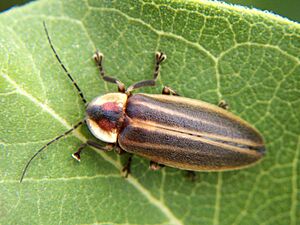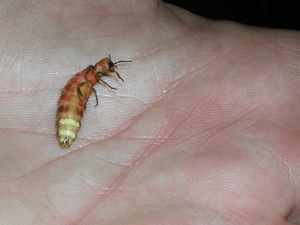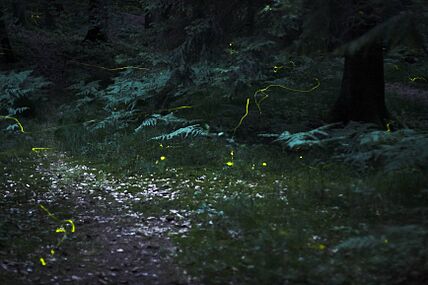Firefly facts for kids
Quick facts for kids Firefly |
|
|---|---|
 |
|
| Photuris lucicrescens | |
 |
|
| Lampyris noctiluca mating | |
| Scientific classification |
|
| Kingdom: | Animalia |
| Phylum: | Arthropoda |
| Class: | Insecta |
| Order: | Coleoptera |
| Suborder: | Polyphaga |
| Infraorder: | Elateriformia |
| Superfamily: | Elateroidea |
| Family: | Lampyridae Rafinesque, 1815 |
| Subfamilies | |
|
Amydetinae Genera incertae sedis: |
|
Fireflies are amazing insects that can create their own light! They are actually a type of family of beetles called Lampyridae. There are over 2,000 different kinds of fireflies known around the world. People often call them lightning bugs or glowworms because of their special ability to glow.
Fireflies use their light to talk to each other, especially to find mates. They usually glow at dusk or night. Scientists think that fireflies first started glowing as a way to warn predators that they taste bad. Over time, this glowing became a way for adult fireflies to find partners. Some female fireflies, like those in the Photuris group, even trick other male fireflies by copying their light patterns. This helps them catch the males as food!
You can find fireflies in many places, especially in warm areas. They love wet, wooded spots or marshes where their young can find plenty of food. All baby fireflies (larvae) glow, but not all adult fireflies do. The part of their body that glows can be different depending on the species and whether it's a male or female. People have been fascinated by fireflies for a very long time. In Japan, for example, people love watching fireflies so much that there are even special parks just for them!
Contents
Firefly Life Cycle

Fireflies are beetles, and they go through a full life cycle just like other beetles. This means they change completely from egg to larva, then to pupa, and finally to an adult.
A few days after mating, the female firefly lays her eggs. She places them on or just under the ground. About three to four weeks later, the eggs hatch into larvae. For some firefly species that live near water, the female lays her eggs on plants in the water. The larvae then drop into the water after hatching.
What Firefly Larvae Eat
Firefly larvae eat and grow all summer long. Most fireflies spend the winter as larvae. They might dig underground or hide under the bark of trees. They come out again in the spring. At least one species, Ellychnia corrusca, spends winter as an adult.
Most firefly larvae are predators. They hunt and eat other small creatures like insect larvae, snails, and slugs. Some larvae are very good at this. They have special grooved jaws that can deliver digestive fluids right into their prey. The larval stage can last from a few weeks to more than two years for some species. After this, they change into a pupa for one to two and a half weeks. Then, they emerge as adult fireflies.
Adult Fireflies
The diet of adult fireflies varies. Some adults are predators, while others eat plant pollen or nectar. Some adult fireflies, like the European glow-worm, don't even have mouths! They only live for a few weeks to mate and lay eggs before they die. Most adult fireflies live for only a few weeks during the summer.
Fireflies come in many shapes, sizes, and colors. The largest ones can be about 1 inch (25 mm) long. Many species have females that look like larvae and cannot fly. You can tell them apart from real larvae because adult females have compound eyes, even if they are small. Larvae only have simple eyes. Most fireflies are active at night, but some fly during the day and usually don't glow. However, some day-flying species that live in shady places can still produce light.
Most fireflies taste bad to animals that might try to eat them. This is because they have special chemicals called lucibufagins. These chemicals are similar to poisons found in some toads. All firefly larvae glow, and this light acts as a warning signal to predators: "Don't eat me, I taste bad!"
How Fireflies Make Light
Fireflies make light through a special chemical reaction called bioluminescence. This happens in special light-producing organs, usually on the lower part of a female firefly's abdomen.
Here's how it works: An enzyme called luciferase mixes with a chemical called luciferin. This reaction also needs magnesium ions, ATP (which is like energy for cells), and oxygen. When these combine, they create light! Oxygen gets to the light organ through tiny breathing tubes.
The light fireflies make is often called "cold light." This means it doesn't produce heat, unlike a light bulb. Their light can be yellow, green, or pale red. Some species, like the "blue ghost" firefly, might look bluish-white from far away, but up close, their glow is bright green.
Light Signals and Communication
Adult fireflies mainly use their light to find a mate. Their flashes are like secret codes! They can change how long the flash lasts, when it happens, its color, how many times it repeats, and even how they fly (up, down, or straight). These flash patterns are different for each species and can even vary in different places.
Some fireflies can even flash their lights all at once, in unison! This is called synchronization. It happens a lot with tropical fireflies, especially in Southeast Asia. Along river banks in Malaysian jungles, thousands of fireflies flash at the exact same time. In the United States, you can see this amazing sight every year in places like Elkmont, Tennessee, in the Great Smoky Mountains, and at Congaree National Park in South Carolina.
Remember the "femme fatale" Photuris fireflies? They copy the flash patterns of smaller Photinus males. When a Photinus male comes looking for a mate, the Photuris female eats him! This gives her the toxic chemicals she needs to protect herself.
Not all fireflies make light. Many species that fly during the day, like those in the Ellychnia group, don't glow. However, some day-flying fireflies that live in shady spots, like the Lucidota genus, can still glow. Fireflies that don't glow use special scents called pheromones to find their mates.
-
Fireflies glowing in the woods near Nuremberg, Germany (30-second exposure photo)
Firefly History
Firefly Fossils
The oldest known firefly fossil is called Protoluciola. It was found in Burmese amber from Myanmar and is about 99 million years old! This ancient firefly already had a light-producing organ, just like modern fireflies. Scientists have studied the genes of living fireflies and believe that the very first fireflies probably glowed green.
Fireflies and People
Protecting Fireflies

Sadly, firefly numbers seem to be going down all over the world. While we don't have all the information, many reports from Europe and Asia suggest that fireflies are in trouble. Recent studies in North America have found that 18 types of fireflies are now at risk of extinction.
Fireflies face many dangers. Their homes are being lost or damaged, and light pollution from human cities makes it hard for them to see each other's signals. Pesticides (chemicals used to kill insects) can harm them directly or reduce the snails and slugs they eat. Poor water quality, new species moving into their areas, and even too many people collecting them are also problems. Climate change is another big threat.
Firefly tourism, where people travel to see fireflies, is growing fast. If not managed carefully, this can also harm fireflies and their homes. Like many other creatures, fireflies are directly affected when land is used for buildings instead of their natural habitat.
Scientists agree that we need to protect firefly habitats. They suggest turning off or reducing artificial lights at night, restoring natural areas where endangered fireflies live, and avoiding unnecessary pesticide use. In 2019, the Sundarbans Firefly Sanctuary was created in Bangladesh to help protect these amazing insects.
Fireflies in Culture
Fireflies have been important in human culture for hundreds of years. In Japan, when fireflies (Japanese: hotaru) appear, it means the seasons are changing. Watching fireflies is a special summer pleasure, and there are parks just for this purpose. There's even a famous Japanese sword from the 14th century called Hotarumaru (Firefly Blade). Its name comes from a legend that fireflies helped fix its flaws one night.
In Italy, the firefly (Italian: lucciola) is mentioned in Dante's Inferno, a famous poem written in the 14th century. Dante compares the glowing flames in one part of Hell to the many fireflies a farmer might see in a valley at dusk.
See also
 In Spanish: Luciérnagas para niños
In Spanish: Luciérnagas para niños






